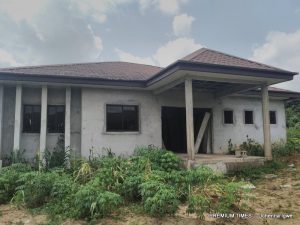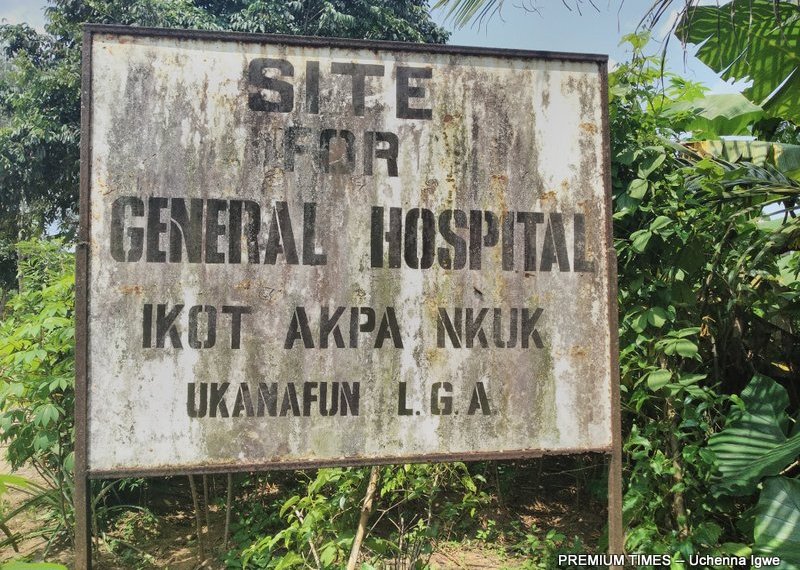By: Israel Umoh
Created 45 years ago, Ukanafun Local Government Area in Nigeria’s 21st state, Akwa Ibom is not lucky in having a secondary health-care facility. Unlike her counterparts created same day- Ikono in Akwa Ibom and Odukpani in Cross River State, Ukanafun is the only oldest but odd local government area and appears to be itinerantly consigned to perish the thought of Health is wealth fad. Hence, the inhabitants are daily living in the shadows of death and death is the only visitor that strikes them without any stud.
In March 2015, Okon Uwah, the one-time executive Chairman of Ukanafun Local Government Area and later a member who represented Ukanafun in Akwa Ibom State House of Assembly visited one of the villages in the area on electioneering campaign.
He never thought and foresaw any tragedy. As he settled down to sell his manifesto, some thugs ambushed and hacked him. His relations and friends picked and rushed him to Uyo, the state capital instead of Ukanafun, a nearby place for first aid and treatment. From Ukanafun to Uyo takes at least one hour’s drive or about 50 kilometres.
By the time Okon reached Uyo, he had given up. If there was a functional Cottage Hospital in the area, he would have been given first aid and would have survived. The death of a one-time Deputy Speaker in the State House of Assembly was a big loss to the area, his family and indeed to the state.
This is one of the many cases of people who have died on a daily basis owing to no functional secondary health facility in the area. Thus, many are forced to patronise the services of churches, prayer houses, sorcerers and herbal treatment practitioners.
Ukanafun At A Glance
Ukanafun Local Government Area was carved out of Abak Division on June 1, 1976 by the late General Olusegun Obasanjo, Nigerian Head of State. The area has a land mass of 254,353sq.km.
Ukanafun has 92 villages, 13 electoral wards and large five clans. The clans are: Northern Afaha, Southern Afaha, Northern Ukanafun, Southern Ukanafun and Adat Ifang.
Etim Ekpo bounds Ukanafun on the North; Oruk Anam on the South; Abia/Rivers States on the East; and Abak on the West. Imo River and QuaIboe River snake through Ukanafun.
Mineral Resources
Ukanafun is the largest producer of gas in Akwa Ibom State. East Gas Nigeria Limited through Accugas Ltd is tapping gas from Ohaobu Village also known as Ikot Inyang Udo 11 in Ukanafun linking pipes through 18 villages in the area via other villages in Akwa Ibom to Odukpani Local Government Area where UNICEM is a major consumer. Before then, the gas pipes were linked and gas was supplied to Aluminium Smelter Company of Nigeria (ALSCON), in Ikot Abasi.
Also, palm produce is major economic activity of the people feeding Imo, Rivers, Lagos and some states in the country. Moreover, crude oil is tapped in commercial quantity.
Throwback At Ukanafun Cottage Hospital
Following the sudden emergence of Prince Vincent Ogbulafor from Abia State as the National Chairman of Peoples Democratic Party (PDP) at the 2008 National Convention held at the Eagle Square, Abuja, with then President Umaru Musa Yar’adua in attendance, political permutations within the country and the ruling party changed. Former Senate President, Sen. Anyim Pius Anyim and former Ebonyi Governor, Dr. Sam Egwu lost their respective bids to the coveted office of Party Chairman.
In Akwa Ibom State, the incumbent governor, Chief Godswill Akpabio had backed Dr. Sam Egwu whose camp was led by Chief Olusegun Obasanjo, the immediate past President, whom Akpabio regarded as his benefactor for going against all odds to endorse him as standard bearer of PDP in the 2007 primary conducted in 2006.
Although Senator Pius Anyim was his colleague in the 1988 Law School session in Lagos, Akpabio preferred to back Dr. Sam Egwu because he feared possible conflict of interest as Senator Anyim was Senate colleague to then Minister of State, FCT, Senator John James Akpanudoedehe during the 1999-2003 session.
It was not surprising that after the convention and the subsequent 10th Anniversary Celebration of PDP held in Uyo , Akwa Ibom State, that Akpanudoedehe lost his place in the Federal Executive Council. Akpanudoedehe had previously served as Chief Campaign Manager for Akpabio during the 2007 Governorship race with Chief Don Etiebet as Chairman of Campaign Council.
The manner of emergence of Prince Vincent Ogbulafor as the National Chairman troubled Akpabio. Ogbulafor had started off in All Peoples Party (APP) seeking to become Governor of Abia State in 1998, but after the elections in 1999 he was appointed Cabinet minister in the new Government of National Unity by Chief Olusegun Obasanjo.
Ogbulafor later joined the PDP and would be elected National Secretary. Akpabio would later find out that under the Abacha political transition programme, Ogbulafor was a member seeking to be Governor of Abia State on the platform of National Centre Party of Nigeria (NCPN) founded by Chief Etiebet as National Leader.
In order to smoothen his relationship with Prince Ogbulafor he proposed the project as possible patronage to Chief Etiebet whose maternal roots are in Ukanafun. In the end it seemed more as Greek gift or Trojan horse. The project was awarded to a company whose CEO had been politically exposed to Chief Etiebet’s politics although an Ukanafun citizen.
The exit of Prince Ogbulafor as PDP Chairman in 2010 following the demise of Umaru Musa Yar’adua and the ascendance to power for Dr. Goodluck Jonathan as President complicated issues for the project. Politics prevailed over need to bring healthcare development nearer the people in Ukanafun since Oruk Anam already had Ikot Okoro Hospital.
WHO Ratio Of A Medical Doctor To Patients
As at 2006, National Population Commission put the population of Ukanafun at 125,473. The commission projected that the population would have risen to 176,300 in 2016.
However, the latest data from the World Health Organization (WHO) reveals that Nigeria’s physician-to-patient ratio is four doctors per 10,000 patients and patients often wait hours to be seen. In the US the ratio is 26 doctors per 10,000 people and 28 in the UK.
Available statistics show that over 40% of WHO Member States report to have less than 10 medical doctors per 10,000 population (over 26% report to have less than 3).
Unfortunately, Nigeria is still far from the recommendations of the World Health Organization (WHO) on the required number of medical personnel to cater efficiently for its teeming population. The federal government disclosed that the ratio of doctor to patient ratio is 1: 2753 which translates to 36.6 medical doctors per 100,000 person.
Shakuri Kadiri, Deputy Director, Head of Human Resources for Health, Federal Ministry of Health, stated this at the launch of the Nigeria Health Workforce Country profile -2018 and handing over of the National Health Workforce Registry in Abuja. WHO recommends 1:600 doctor-patient ratio.
So far, the area boasts of Primary Health Care Operational Health Base at Ikot Akpa Nkuk. There are health centres at Adat Ifang , Nsekhe, Ikot Udo Ossiom, Ikot Unah, Ohaobu, Northern Afaha, Afaha Ikot Inyang , Afaha Odon, and Ikot Okusung.
Health posts are sited in Nkek, Ikot Ebok, Afaha Ikot Akwa, Ikot Odiong, and Ntokon. The Tuberculosis and Leprosy (TBL) Clinic, Ikot Otoiwo should be reactivated.
Going by the projected population of Ukanafun for 2016, the area is running a big deficit in health-care delivery services. The ratio is 0:100,000 (medical doctor/people).
Investigation by Straightnews shows that an NYSC medical doctor was usually posted to the PHC Base at Ikot Akpa Nkuk, but has not been posted to the area for a long time now.
From Ikot Akpa Nkuk to General Hospital, Ikot Okoro in Oruk Anam Local Government Area takes more than 40 kilometres; from Ikot Akpa Nkuk to Divine Love Hospital, Utu Etim Ekpo in Etim Ekpo takes more than 35 kilometres while from Ikot Akpa Nkuk to Mercy Hospital, Abak takes more than 45 kilometres. These are secondary health-care facilities.
In addition, virtually all the roads are in deplorable state. Ekparakwa-Ikot Akpa-Nkuk-Iwukem Federal Highway is deplorable while Ikot Anta-Nkek-Ikot Udo Obobo-Ekeffe Road is usually rendered impassable during rainy season. So, the residents live between the proverbial Devil and the blue deep sea.


